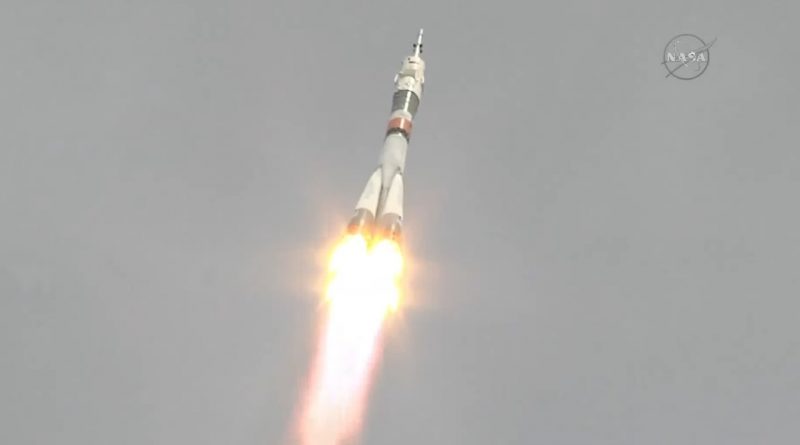Flawless Soyuz Launch Places U.S.-Russian Crew Duo on Expressway to ISS
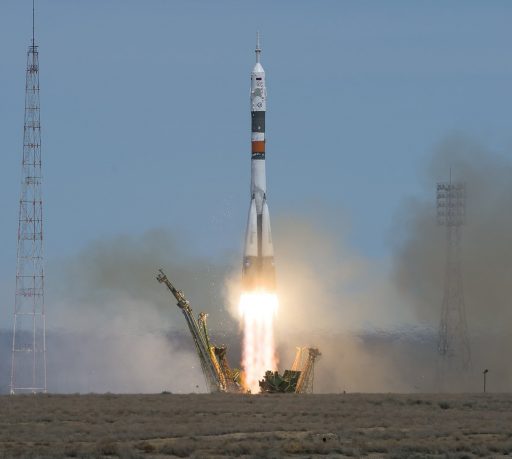
Russia’s Soyuz rocket successfully lifted a two-man crew from Russia and the U.S. into orbit and on the fast lane to the International Space Station on Thursday, blasting off from the world’s oldest spaceport in Kazakhstan.
The trusted Soyuz FG rocket lifted off from Site 1/5 at the Baikonur Cosmodrome at 7:13 UTC, carrying into orbit the Soyuz MS-04 spacecraft manned by fifth-time space flier and third-time Soyuz commander Fyodor Yurchikhin and NASA’s Jack Fischer – embarking on a mission of over 2,000 laps around the Earth as part of ISS Expedition 51 and 52.
Soyuz, flying under the Greek name ‘Argo’ after the mythological ship – blazed into overcast skies over the Kazakh launch site under the loud thunder of its four liquid-fueled boosters and large core stage, climbing uphill with a thrust of over 420 metric ton-force to lift the 7,200-Kilogram spacecraft into orbit for a high-speed pursuit of the Space Station.
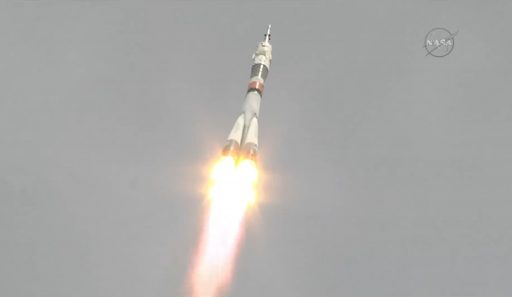
Heading toward the Russian border, the 49-meter tall Soyuz dropped its four boosters two minutes after liftoff and the central core handed off to the Block I upper stage just shy of five minutes into the flight. Block I fired its four-chamber engine for close to four minutes before the Soyuz spacecraft separated from its carrier rocket eight minutes and 48 seconds after launch, marking the 59th successful launch for the Soyuz FG rocket.
Veteran Soyuz Commander Fyodor Yurchikhin confirmed all was in order aboard the capsule, setting sail on an expedited rendezvous with the Space Station designed to bring crew’s to their orbital destination just six hours after launch. Over the course of four orbits, Soyuz will conduct several engine firings to ascend from 200 Kilometers in altitude to the Station’s 400-Kilometer orbit for a fully automated link-up culminating in a planned 13:23 UTC docking to the Poisk module to mark the start of a four and a half-month stay.
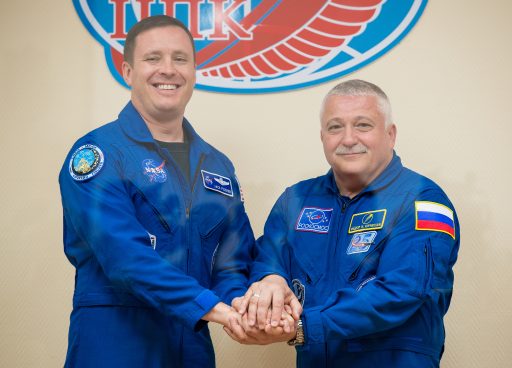
Thursday’s launch marks the first Soyuz mission with two instead of three crew members since Soyuz TMA-2 that lifted off from the same Baikonur launch pad in April 2003 with ISS Expedition 7 crew members Yuri Malenchenko and Ed Lu.
Taking effect with last week’s landing of Soyuz MS-02 and Thursday’s MS-04 launch is a reduction in the Russian crew contingent aboard ISS from three to two permanent members – a decision announced by Roscosmos last year to save money on cargo missions and training resources while awaiting the launch of the long-delayed Nauka science module that would justify ramping the Russian crew up to three again.
Both men launched on Thursday are looking forward to an eventful mission filled with world-class science performed aboard the orbiting laboratory as well as spacewalks to outfit the exterior of the complex for future operations. Yurchikhin and Fischer will join the Expedition 51 crew of Commander Peggy Whitson, ESA Astronaut Thomas Pesquet and veteran Cosmonaut Oleg Novitskiy for six weeks of five-crew operations that will see the arrival of a commercial resupply craft, the deployment of over 30 satellites and a U.S.-based spacewalk by Whitson and Fischer on May 12.
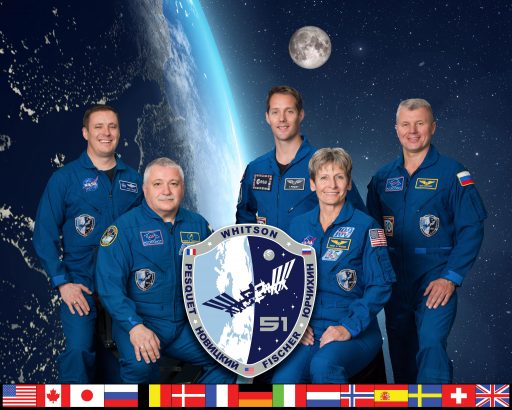
Peggy Whitson, NASA’s most experienced female astronaut, will surpass Scott Kelly on April 24 and take the record for most days spent in space by an American Astronaut. She plans to switch from the Soyuz MS-03 crew over to the MS-04 spacecraft to extend her stay aboard ISS from an early June departure to September to keep an extra pair of hands on station and avoid an extended period of two-crew operations in the summer.
Whitson, Yurchikhin and Fischer will have the station to themselves from June through late July, overseeing the arrival of the next SpaceX Dragon and a Russian Progress supply vehicle while also supporting dozens of experiments underway aboard ISS at any given time. Sergei Ryazansky, Randy Bresnik and Paolo Nespoli will arrive on July 28 to restore the Station’s crew to six – now with four USOS residents and two Russian crew members. Ryazansky and Yurchikhin will venture outside on a spacewalk in August, marking the first Russian EVA in two years and debuting new space suits
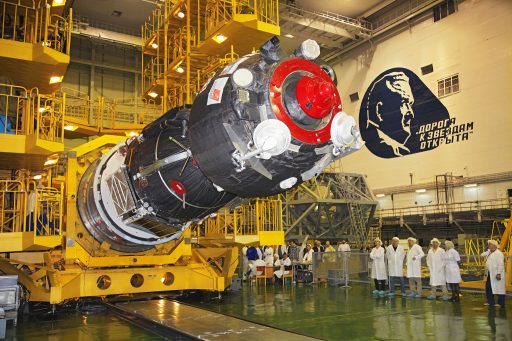
The crew’s focus will be on science – 216 experiments will be conducted aboard the U.S. Segment over the course of Expedition 51/52, covering virtually all branches of science. For many of them, the crew members themselves will act as test subjects to learn about the effects of the space environment on different bodily systems – knowledge that is required to achieve longer and longer mission durations through the implementation of improved countermeasures preventing the negative effects of space radiation and microgravity-induced bone & muscle loss.
Per the current schedule, Soyuz MS-04 with Yurchikhin, Fischer and Whitson will depart ISS on September 3 to head toward a parachute-and-rocket-assisted landing in the steppe of Kazakhstan after a flight of 136 days for Yurchikhin and Fischer and 289 days for Whitson.
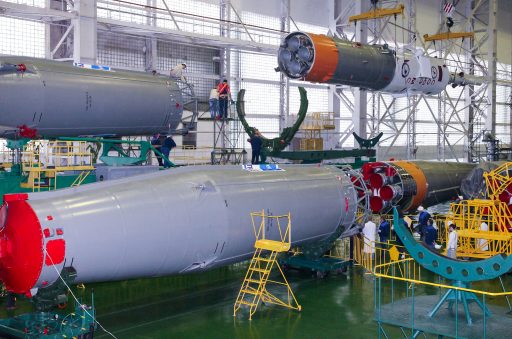
Originally, Yurchikhin and Fischer were set for a stay of five and a half months, but their launch slipped nearly four weeks after Soyuz #734 – originally intended to fly the MS-04 mission – experienced a coolant leak, requiring it to be replaced with the next spacecraft in line. The subsequent delay to the mission was based on where Soyuz #735 was in its processing flow, also affecting the Soyuz MS-05 flight that is being moved from a late May liftoff to launching in late July as Soyuz #736 has to be brought forward in its production and testing flow. #734 will fly the Soyuz MS-06 mission in September after completion of repairs and re-testing.
Despite the month-long delay, operations proceeded smoothly at the Baikonur Cosmodrome in a well-oiled machine of human spaceflight operations with the Soyuz, optimized over a fifty-year career of the spacecraft. Soyuz MS-04 – the 133rd Soyuz – underwent final vacuum checks in March, was loaded with propellants earlier in April and met its Soyuz FG rocket over the weekend ahead of an early morning rollout on Monday to begin the final on-pad campaign, setting up for a Thursday liftoff.
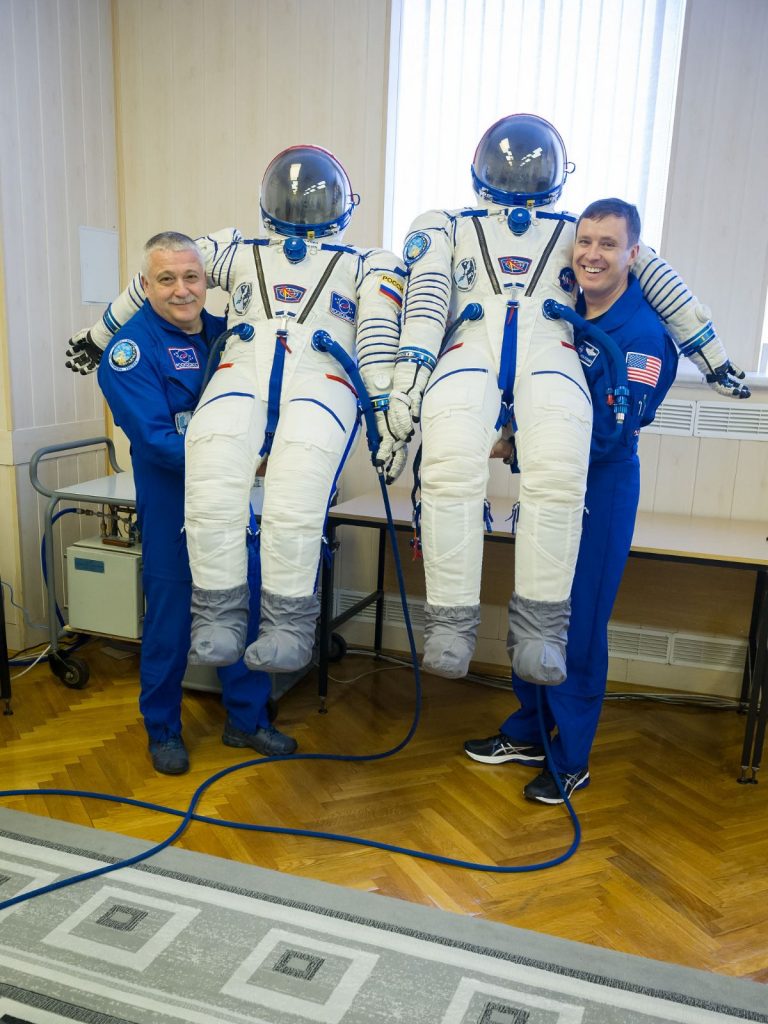
The two crew members for this mission arrived at the Cosmodrome two weeks prior to liftoff for final inspections of their Soyuz and the typical pre-flight quarantine as well as plenty of traditions in place for a crew’s departure from the storied spaceport.
Soyuz MS-04 Commander Fyodor Yurchikhin is a veteran of four missions to space including three long-duration assignments as part of ISS Expeditions. He worked as a spaceflight engineer and Mission Controller before becoming a Cosmonaut in 1997, making his first flight five years later aboard Space Shuttle Atlantis on the STS-112 mission, visiting the Space Station when it was still in its infancy. Yurchikhin amassed a total of 537 days in orbit during his Shuttle mission and as part of ISS Expeditions 15, 24/25 and 36/37, ranking 13th on the all-time list for time spent in space and 7th on the EVA record list with eight career spacewalks for nearly 52 hours.
Jack Fischer, a test pilot in the U.S. Air Force, was selected by NASA in 2009 and qualified as an astronaut in 2011. Prior to his current occupation, Fischer served combat tours in Iraq and Afghanistan, and participated in testing of the F-22 Raptor, accumulating over 3,000 hours flying more than 45 types of aircraft. He was originally assigned to ISS Expedition 52/53, but the reshuffling of crews associated with the Russian crew reduction brought his mission forward.
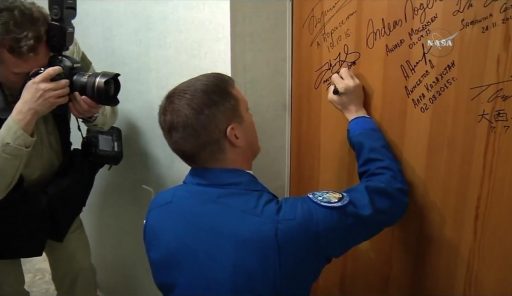
The crew received a 4 a.m. wakeup call at the Cosmonaut Hotel to enter their final personal preparations for liftoff, starting a day of nearly 24 hours that will end with them in their bunks aboard ISS several hours after their arrival on Station.
After the typical routine of showering, breakfast and signing their hotel room doors, the two crew members received the traditional pre-flight blessing before departing the hotel. At Site 254 of the Cosmodrome, the crew put on their Sokol Launch and Entry Suits and had a final face-to-face conversation with their families prior to departing for the launch pad at Site 1/5.
Site 1/5 was supporting its 506th launch on Thursday, having been the on-ramp to space for many notable missions including the launch of Sputnik six decades ago and Yuri Gagarin’s historic flight in 1961.
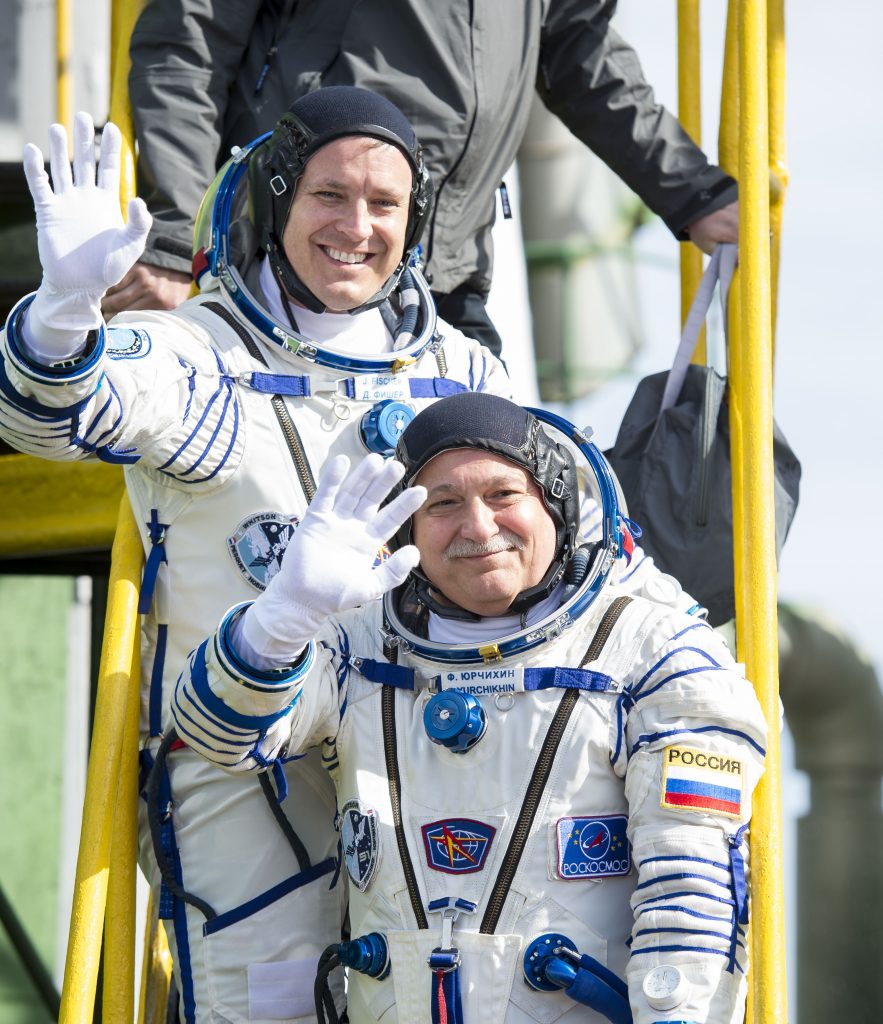
Out at the pad, Soyuz FG entered countdown operations eight hours prior to launch with a multi-hour testing campaign and final preparations for fueling. The green light for the propellant loading sequence came at T-5 hours after the Russian State Commission reviewed the results of launch vehicle testing and the status of the Countdown.
274 metric tons of Liquid Oxygen and Kerosene propellants were loaded into the Soyuz over a two-hour sequence and the boosters and core stage also received Liquid Nitrogen to keep the tanks pressurized during flight and Hydrogen Peroxide to power the engine pumps.
Arriving at the launch pad two and a half hours before liftoff, the crew duo saw their assembled Soyuz for the first time before riding the elevator up to their spacecraft fifteen stories above the ground. The Soyuz ‘left-seater’ Jack Fischer was first to climb into the spacecraft before third-time Soyuz Commander Yurchikhin was strapped into the center seat while the right seat held a cargo container. The crew then went through 80 minutes of setup steps to configure the Soyuz for flight before being entertained with music through the comm loop to make the wait for liftoff a bit shorter.
The fully-fueled Soyuz FG was revealed on its pad 40 minutes ahead of launch when the large Service Structure halves were lowered to the ground, clearing the way uphill for the 305-metric ton rocket.
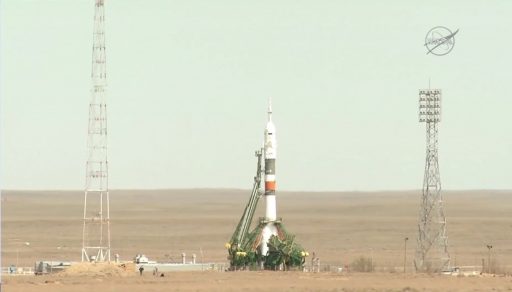
Soyuz MS-04 went to battery power before clocks entered the final six minutes of the countdown and operations switched into a highly choreographed automatic mode when the Launch Key – a relic of Soyuz’s past career – was inserted to authorize the launch. Inside the nearby launch bunker, teams watched over the Soyuz as the rocket went through the purge of its engines, pressurization of tanks and the transition to onboard control.
Soyuz was handed full control over the countdown at the T-1 minute mark and the umbilical masts began retracting from the rocket. Upon reception of the launch command at T-20 seconds, Soyuz began spinning up its engine pumps and fired igniters in the RD-107A booster and RD-108A core stage engines, soaring to a collective liftoff thrust of 422 metric ton-force to overcome counterweights and lift off the ground.
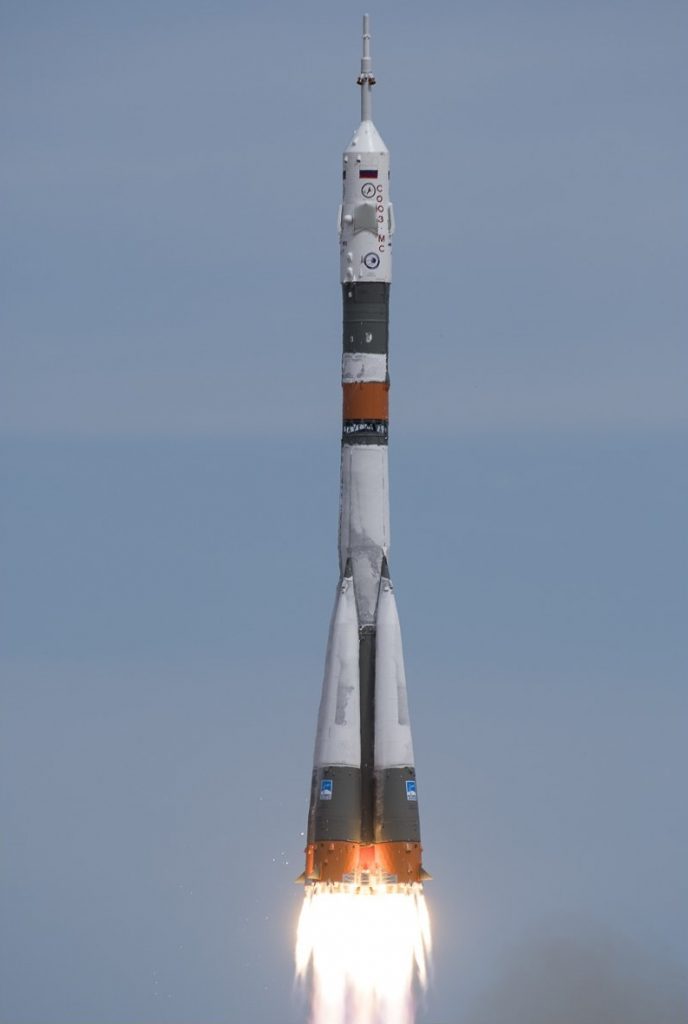
Soyuz began rising from its pad at the exact moment of 7:13:44 UTC, just three minutes after the Space Station passed directly over the Baikonur Cosmodrome. Starting its high-speed pursuit of the orbiting complex, Soyuz climbed vertically for the first twenty seconds of flight before pitching over to depart Baikonur to the north-east, heading toward the Russian-Kazakh border to dispatch the spacecraft directly into the orbital plane of the Space Station, trailing the complex by some 3,500 Kilometers.
Having flown over 1,800 missions, Soyuz is unparalleled in the world of orbital launchers both in terms of flight heritage and reliability. Built on the R7 design by Sergei Korolev, Soyuz has supported crewed missions, cargo flights and satellites headed to all types of orbits.
Soyuz blazed into the afternoon skies over Baikonur, powering through the speed of sound just over one minute into the flight and encountering Maximum Dynamic Pressure on its way uphill. Firing on all cylinders, Soyuz consumed 1,600 Kilograms of propellant per second with its boosters doing most of the heavy lifting to send Soyuz on its way.
The jettisoning of the Launch Escape Tower at T+1 minute and 54 seconds into the flight was quickly followed by the separation of the four boosters after they helped accelerate the Soyuz to a speed of 1.5 Kilometers per second. After each consumed 39,600 Kilograms of propellant, the 19.6-meter long boosters shut down their engines and were pushed outward and away from the still-firing core stage – forming what is known as the Korolev Cross, only visible for a split second as the four boosters rotate away from the central core.
With the boosters tumbling toward an impact 348km from the launch site, Soyuz continued toward space relying on its core stage alone, generating a vacuum thrust of 102 metric ton force. Two minutes and 37 seconds into flight, Soyuz shed no-longer-needed weight by jettisoning the launch shroud after passing 85 Kilometers in altitude where aerodynamic forces are no longer a threat to the spacecraft.
Toward the end of the Core Stage’s burn, the two crew members were pushed into their seats at a force peaking at nearly 4Gs as the core’s tanks were nearly empty while the engine maintained its full throttle setting.
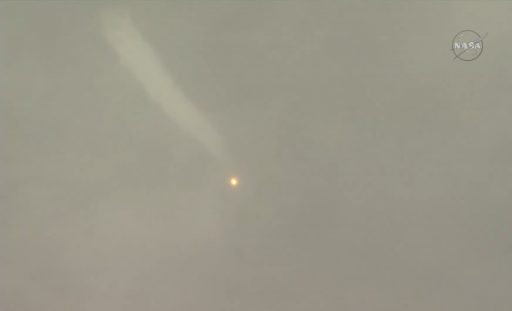
Onboard cameras showed the moment of core stage shutdown 4 minutes and 45 seconds into the flight when the crew was visibly thrown forward in their seats as thrust from the RD-108A was cut off after consuming 91 metric tons of propellant. Split seconds later, the third stage’s RD-0110 engine was commanded to start and pyrotechnic charges fired to separate the 27.8-meter long core that had fulfilled its role in the day’s mission, lifting Soyuz to 140 Kilometers in altitude and accelerating it to a speed of 3.7 Kilometers per second.
After ignition, all eyes were on the Block I stage of the Soyuz rocket that was re-fitted with a new 11D55 engine earlier this year using an engine built in 2016. The previously installed engine was from a lot produced in 2014 that was feared defective following December’s engine-related failure of the penultimate Soyuz U rocket, resulting in the loss of the Progress MS-04 cargo craft.
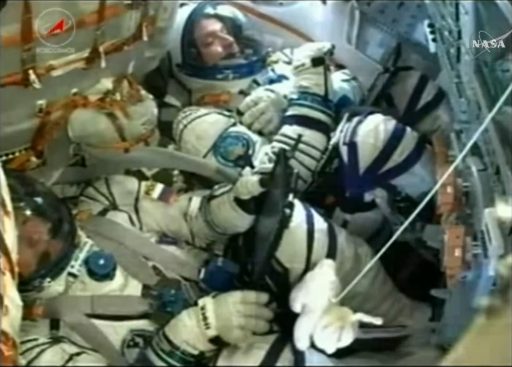
Soaring to a thrust of 30,400 Kilogram-force, Block I was set for a burn of three minutes and 58 seconds to accelerate the Soyuz by another 4km/s to reach orbital velocity. Calls made from the Launch Bunker based on realtime telemetry indicated good stabilization throughout third stage flight with good performance by the RD-0110 and its four gimbaling verniers.
Onboard camera views showed the familiar jolt at T+8 minutes and 45 seconds when raw rocket power faded to the sensation of microgravity for the two crew members and their Zero-G mascots – toys given to Fyodor Yurchikhin by his children and a an emblem of the MD Anderson Cancer Center in Houston where Jack Fischer’s daughter was treated.
Separation of the Soyuz spacecraft was confirmed three seconds after engine cutoff and, only a few seconds later, the two power-generating solar arrays and KURS navigation antennas automatically deployed through time-tagged commands. With the major step of launch out of the way, the crew had no breathing room given the dense timeline of the four-orbit express rendezvous profile – marking the first time the fast flight profile is used by the improved Soyuz MS vehicle.
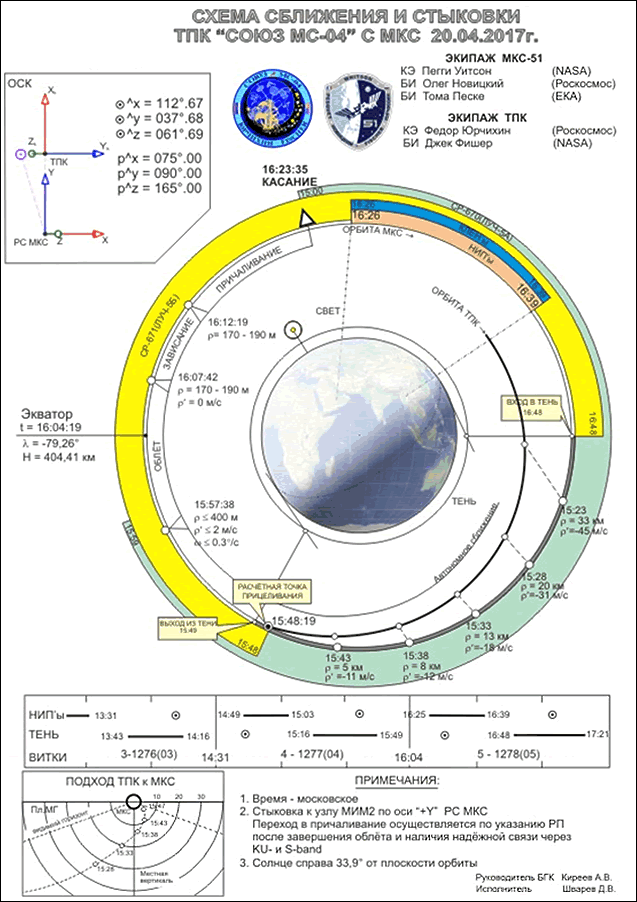
The same-day rendezvous was inaugurated in 2013 and used by the majority of Soyuz missions since then, however, Progress and Soyuz MS missions had to stick to the scenic route until now because a ground station in Russia’s far east had not yet finished outfitting to provide S-Band uplink capability through the new Unified Command and Control System of the MS vehicle. This ground station was demonstrated during the Progress MS-05 mission and is now ready for operation, allowing Soyuz MS-04 to reach ISS fast than a typical trans-Atlantic flight.
Flying under the call sign ‘Olimp’ (Olympus), Soyuz went through an initial check of its flight control system and the KURS radio navigation system while Mission Controllers also confirmed the capsule was holding pressure. Delivered to an insertion orbit of 200 x 242 Kilometers, Soyuz will be tasked with a series of main engine firings to link up with the Space Station in its 399 x 409-Kilometer orbit just six hours after liftoff.
Embarking on its first lap around Earth, Soyuz was to stabilize its orientation and initiate communications through Russia’s Luch relay satellites, allowing Mission Control to keep in touch with the crew and receive telemetry for the majority of the craft’s orbital trek. A pair of main engine burns were already loaded into the Soyuz craft prior to launch, set for 42 and 80 minutes into the mission to accelerate the craft by 21.6 and 23.9 meters per second, respectively. These two firings of the 300-Kilogram force SKD propulsion system will raise the mean altitude of the Soyuz by 70 Kilometers ahead of two more firings on the second orbit. These two burns will be recalculated based on measured insertion orbit parameters to position the Soyuz for the initiation of its automated rendezvous at 11:12 UTC.
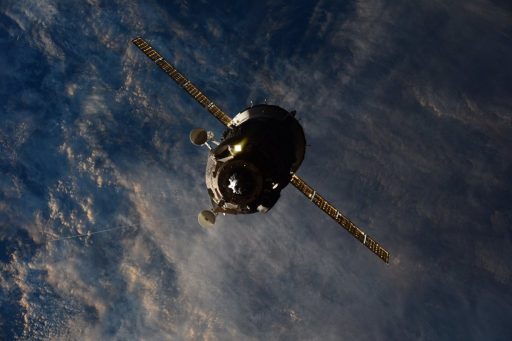
The Automated Rendezvous process begins with another ground-targeted engine burn that will place the Soyuz on course into the 200-Kilometer communications zone around ISS where KURS will be activated to guide Soyuz into the direct vicinity of the complex through a series of engine burns. Arriving on the Station’s doorstep, Soyuz will put on the brakes and complete a slow lap around ISS starting at a range of 400 meters to bring the spacecraft into position for a straight-in approach to the Poisk module.
Docking is planned at 13:23 UTC, but the exact timing will vary depending on the spacecraft’s progress during rendezvous. Upon sensing contact with the Poisk module, Soyuz will fire its DPO thrusters to ensure capture latches engage within the docking mechanism to securely hold the spacecraft in place.
After pulling into its orbital docking port, Soyuz will go through the usual routine of leak checks, transfer to ISS communications and power, all while the crew members can get out of their Sokol suits and prepare to trade the confined space of Soyuz with the comforts of ISS. Hatch opening occurs around two hours after the crew’s arrival, raising the ISS crew to five for the next six weeks of operations as part of Expedition 51.

